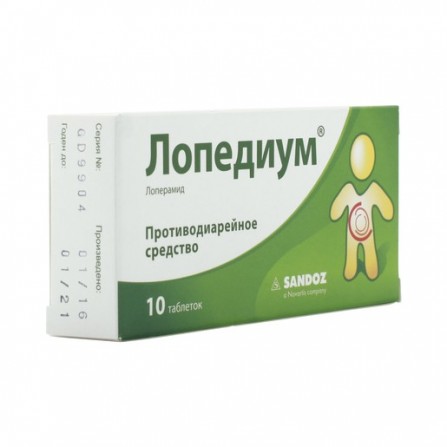More info
Active ingredients
Loperamide
Release form
Pills
Composition
Active ingredient: Loperamide hydrochloride Concentration of active ingredient (mg): 2
Pharmacological effect
Symptomatic antidiarrheal drug. Linked to the opioid receptors of the intestinal wall, loperamide reduces the tone and motility of the smooth muscles of the intestine. Slows peristalsis and increases the time of passage of intestinal contents. Increases the tone of the anal sphincter. Contributes to the retention of feces and the reduction of the urge to defecate. The action comes quickly and lasts 4-6 hours.
Pharmacokinetics
Absorption of loperamide - 40%. The time to reach Cmax is 2.5 hours. The distribution of plasma protein binding is 97%. Does not penetrate through the BBB. Metabolism Almost completely metabolized in the liver by conjugation. Excretion Excreted mainly in bile and urine. T1 / 2 is 9-14 hours.
Indications
On the part of the endocrine system: replacement therapy for primary and secondary (pituitary) adrenal insufficiency, congenital adrenal hyperplasia, subacute thyroiditis and severe post-ray thyroiditis. Rheumatic diseases: rheumatoid arthritis (including juvenile chronic arthritis) and extra-articular lesions in rheumatoid arthritis (lungs, heart, eyes, cutaneous vasculitis). Systemic diseases of the connective tissue, vasculitis and amyloidosis (as part of combination therapy): systemic lupus erythematosus (treatment of polyserositis and lesions of internal organs), Sjogren's syndrome (treatment of lesions of the lungs, kidneys and brain), systemic sclerosis (treatment of myositis, pericarditis and alveolitis), polymyositis, dermatomyositis, systemic vascus Ites, amyloidosis (replacement therapy for adrenal insufficiency), scleroderma. Skin diseases: pemphigoid, bullous dermatitis, herpetiform dermatitis, exfoliative dermatitis, exudative erythema (severe forms), erythema nodosum, seborrheic dermatitis lichen, fungoid mycoses, angioedema, bronchial asthma, contact dermatitis, atopic dermatitis, serum sickness, allergic rhinitis, drug disease (hypersensitivity to drugs), nettle ICA after blood transfusionsystemic immune diseases (sarcoidosis, temporal arteritis). Eye diseases: proliferative changes in the orbit (endocrine ophthalmopathy, pseudotumor), sympathetic ophthalmia, immunosuppressive therapy for corneal transplantation. exacerbations), chronic autoimmune hepatitis, rejection after liver transplantation. Blood diseases: congenital or acquired acute pure aplastic anemia, autoimmune hemol anemia, secondary thrombocytopenia in adults, erythroblastopenia, acute lymphoblastic leukemia (induction therapy), myelodysplastic syndrome, angioimmunoblastic malignant T-cell lymphoma (in combination with cytostatics) immunocytomas, systemic histiocytosis (systemic process). Kidney diseases: primary and secondary glomerulonephritis (Goodpasture syndrome), kidney damage in systemic diseases vaniyah connective tissues (systemic lupus erythematosus, Sjogren's syndrome), systemic vasculitis (usually in combination with cyclophosphamide), glomerulonephritis with polyarteritis nodosa, Churg-Strauss syndrome, Wegener's granulomatosis purpura Shonlyayna-Schonlein purpura, mixed cryoglobulinemia, renal disease in Takayasu's arteritis, interstitial nephritis , immunosuppressive therapy after kidney transplantation, induction of diuresis or reduction of proteinemia in idiopathic nephrotic syndrome (without uremia) and kidney damage on the background of the system me lupus erythematosus. Malignant diseases: palliative therapy of leukemia and lymphoma in adults, acute leukemia in children, hypercalcemia in malignant neoplasms. Other indications: tuberculous meningitis with subarachnoid block (in combination with adequate anti-tuberculosis therapy), trichinosis with neurological or myocardial manifestations.
Contraindications
Diverticulosis, intestinal obstruction, ulcerative colitis in the acute stage, diarrhea on the background of acute pseudomembranous enterocolitis, as monotherapy for dysentery and other gastrointestinal infections; I trimester of pregnancy; lactation period; children under 6 years old; use the drug in patients with liver failure.
Use during pregnancy and lactation
If there is no effect after 2 days of using Lopedium, it is necessary to clarify the diagnosis and exclude infectious genesis of diarrhea. It is necessary to replace the loss of fluid and electrolytes. Each tablet or capsule of the drug Lopedium corresponds to 0.01 XE. Impact on the ability to drive vehicles and control mechanisms. Luciano occurrence of drowsiness or dizziness, avoid driving and using machinery.
Dosage and administration
The drug should be taken orally, pills and capsules swallowed, not chewed, with 100 ml of water. Adults with acute and chronic diarrhea are prescribed initially 4 mg, then 2 mg after each defecation in the case of liquid stool. The maximum daily dose is 16 mg. Children over 6 years old are prescribed 2 mg after each defecation in the case of loose stools. The maximum daily dose is 6 mg. After normalization of the stool or in the absence of stool for more than 12 hours, treatment should be discontinued.
Side effects
Clinically significant interaction of loperamide with other drugs has not been established.
Overdose
On the part of the digestive system: gastralgia, dry mouth, nausea, vomiting, intestinal colic, constipation; very rarely - intestinal obstruction. For the central nervous system: drowsiness or insomnia, dizziness, headache. Allergic reactions: skin rash.
Interaction with other drugs
Precautionary measures
special instructions
Symptoms: CNS depression (stupor, impaired coordination, drowsiness, miosis, muscle hypertonus, respiratory depression), intestinal obstruction. Treatment: antidote - naloxone. Since loperamide has a longer duration of action than naloxone, it is possible to reintroduce the latter. Conduct symptomatic therapy (activated carbon, gastric lavage, mechanical ventilation). Medical observation of the patient for at least 48 hours is required.





